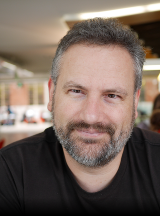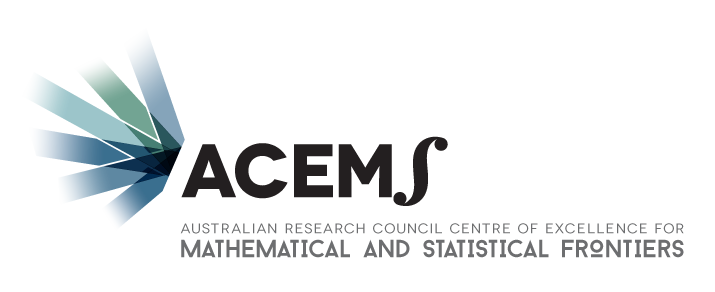The ACEMS Workshop on Challenges of Data and Control of Networks is broad-ranging workshop covering topics in measurement, management and control of networks. In particular, we want to consider networked cyber-physical systems (often security systems), but other topics from wireless, WWW, and other network management settings are welcomed. The workshop has a strong theme of data that is hard to acquire, hard to work with, and hard to analyse often in the context of cyber-security.
This years event is aimed at building on the success of the
- The 1st workshop.
- The 2nd workshop.
Key Information:
Locations: Adelaide, Australia
- Reception: Level 5, Inkgarni Wardli Building, University of Adelaide, Australia
- Workshop: Joint Cyber Security Centre (JCSC), Level 26, 91 King William Street.
Dates: Monday 20th – Tuesday 21st January, 2020 (with reception on the 19th)
Contact Info: Matthew Roughan, matthew.roughan@adelaide.edu.au
Program:
Rough schedule and locations
- Sun 19th: 5.00-6.00 Meet and Greet (Level 5, Inkgarni Wardli Building, University of Adelaide).
- Mon 20th: 9.00-5.00 Technical Talks (JCSC, Level 26, 91 King William Street).
- Mon 20th: 6.00-10.00 Dinner at the British Hotel in North Adelaide.
- Tues 21st: 9.30-12.30 Technical Talks, and wrap up
Detailed program
| Day | Time | |
|---|---|---|
| Sun | 5.00-6.00pm | Meet and Greet, Wine and beer on level 5 (Inkgarni Wardli) |
| Mon | 9.00-9.25 | Coffee |
| 9.25-9.30 | Welcome | |
| 9.30-10.30 | Randy Bush, Through a Glass Darkly | |
| 10.30-11.00 | Morning Tea | |
| 11.00-12.00 | Cristel Pelsser, Securing workflows using microservices | |
| 12.00-2.00 | Lunch | |
| 2.00-3.30 | Short talks: | |
| Maxime Mouchet, IMT Atlantique, | ||
| Juri Kononov, SMIT, Network Management Challenges in a service rich environment | ||
| Hassan Habibi Gharakheili, UNSW | ||
| 3.30-4.00 | Afternoon tea | |
| 4.00-5.00 | Geoff Huston, The Internet as seen by the User | |
| 6.00 (for 6.30) | Dinner at the British Hotel in North Adelaide. | |
| Tues | 9.30-10.30 | Olaf Maennel, Critical Infrastructure Protection: An Aviation Cybersecurity Perspective |
| 10.30-11.00 | Morning tea | |
| 11.00-12.30 | Short talks: discussion and wrap up | |
| Jason Xue, University of Adelaide | ||
| Andrew Feutrill, Data61 | ||
| Matt Sorell, University of Adelaide, Mobile network records as forensic evidence | ||
| Matt Roughan, ACEMS and Uni. of Adelaide |
Keynote Speakers:
Talk: Through a Glass Darkly
Looking for signal suppression, BGP Route Flap Damping, in a network which already massively suppresses signal by design, BGP Best Path. A very cursory look at BGP so we can understand Route Flap Damping, and then the experimental setup and how we are trying to measure RFD’s deployment.
Bio: Randy Bush is a Research Fellow and Network Operator at Internet Initiative Japan, Japan’s first commercial ISP. He is also a Member of Technical Staff at the routing platform vendor Arrcus, Inc. He specializes in network measurement especially routing, network security, routing protocols, and IPv6 deployment. He was a lead designer of the BGP security effort. Randy has been in computing for over 50 years, and has a few decades of Internet operations experience. He was a founder of Verio, which is now NTT/Verio. He was among the inaugural inductees into the Internet Society Internet Hall of Fame in 2012. He has served as a member of the IESG and in various other roles within the IETF. He was also a founder of the Network Startup Resource Center (NSRC), http://www.nsrc.org/, an NSF-supported pro bono effort to help develop and deploy networking technology in the developing economies. In amongst these activities he is also an active researcher, and is co-author of a number of papers; see see http://archive.psg.com/papers.html.
Cristel Pelsser, Universite de Strasbourg
Talk: Securing workflows using microservices
Data leaks and breaches occur more and more often. Those exposures are perceived as huge losses of money for businesses like the movie industry, and as privacy loss for applications dealing with user data. There has been a steady increase in the number of breaches reported over the past eight years [1], 2019 being an all-time high with 5183 reported breaches as well as 7995 million records lost [1]. Malicious actors have been responsible for most incidents, but accidental exposure of data on the Internet (e.g. misconfigured databases, backups, end points, services) has put the most records at risk [1].
It is common for businesses to process and share information with contractors. It can be the elements of a movie in post-production or results of medication testing, for example. Here we propose a secure environment for the deployment of such workflows. We present the desired security properties such as data leak prevention, data encryption in transit and at rest. We then show how we propose to secure such workflows using Istio. We show how access policies are distributed and enforced on the different pieces of the infrastructure.
[1] Risk Based Security. Data Breach Quickview Report 2019 Q3 trends. 2019
Bio: Cristel Pelsser is a professor at the University of Strasbourg. Her research focusses on core Internet technologies. Her aim is to facilitate network operations, avoid network disruptions and, when they occur, pinpoint the failure precisely in order to quickly fix the issue. Cristel obtained her PhD at the Université catholique de Louvain (UcL) in Belgium. She was then a post doc at NTT laboratories and a researcher at Internet Initiative Japan both in Tokyo. She is the winner of the Best paper award at DRCN 2016, and the Applied Networking Research Prize of the Internet Research Task Force (IRTF) in 2013.
Talk: The Internet as seen by the User
Abstract: Many Internet experiments use “opportunistic measurement.” They measure what they can measure and attempt to infer more general characteristics from this limited measurement. The problem is that in large complex systems the relationship between system behaviour and the behaviour of individual elements is not readily correlated. The the Internet as a service the most useful and directly relevant measurements are those made from the perspective of the end user.
In this presentation I would like to look at a measurement approach that uses online ads as the medium to perform a large scale distributed measurement. This presentation will look how this is done, and look at the type of measurements that can be performed in this way, and how this can inform our understanding of service delivery to users in the Internet.
Bio: Geoff Huston is the Chief Scientist at APNIC, the Regional Internet Registry serving the addressing needs of the Asia Pacific community. His research interests include inter-domain routing protocol and routing security, addressing, the domain name system and protocol engineering. At APNIC he operates one of the largest measurement platforms on the Internet, looking at aspects of IPv6 adoption, DNS security and network performance. He was the Chief Internet Architect at Telstra, and previously he was the manager of the Australian Academic and Research Network (AARNet). He has been named in the Internet Hall of Fame for his contributions bringing the Internet to Australia in the 90s.
Olaf Maennel, Centre of Digital Forensics and Cyber Security at Tallinn University of Technology
Talk: Critical Infrastructure Protection: An Aviation Cybersecurity Perspective
The aviation industry has embraced a safety-oriented culture probably more than any other transport sector. However, from a cybersecurity perspective it is increasingly vulnerable. Previously separate systems are now being interconnected in order to enhance efficiencies, reduce costs and improve the customer experience. However, this exposes new vulnerabilities that may be exploited by a variety of threat actors. These range from nation states to cyber criminals who will see aviation as an attractive target for financial gain, invading privacy or just creating chaos. Airport systems running commercial software are also at risk from indiscriminate attacks targeting any insecure Internet connected network that can be remotely accessed. The unique attributes of the aviation sector serve as a good example of how cybersecurity research needs to develop systems able to resist and counter multiple attack vectors. These have the potential to be also applied across a range of other critical national infrastructures with similar cyber risks that must be effectively and comprehensively mitigated. In our research we demonstrate that securing the aviation industry requires a holistic and wide-ranging approach incorporating aspects from both technical and social science disciplines. This will be illustrated by looking at some of the challenges encountered from a range of cybersecurity exercises & training programmes.
Bio: Olaf Manuel Maennel is Professor for cybersecurity. He graduated from the Technical University Munich in 2005. Since then he has been with the University of Adelaide in Australia and Loughborough University in UK. In July 2014 he has joined Tallinn University of Technology and the Centre of Digital Forensics and Cyber Security. His research interests include critical transportation infrastructure protection (with a focus on aviation & maritime cyber security aspects), network security, network forensics, and serious games (focusing on red-teaming and learning aspects). He is also responsible for international admissions and was co-chairing ACM SIGCOMM 2015, ACM IMC 2017, the Global Internet Symposium GI’2017, and also co-chaired three Interdisciplinary Cyber Research workshops—ICR (aiming at bringing together techies and lawyers). He also serves as EU expert evaluator and vice-chair for Horizon H2020 calls.
Registration
Workshop numbers will be strictly limited with preference given on a first come basis.
Registration is free for participants.
Local Arrangements
Possible accommodation locations in the city are
But there are several others nearby.
Sponsorship
- ACEMS
- University of Adelaide
- Joint Cyber Security Centre (JCSC)


